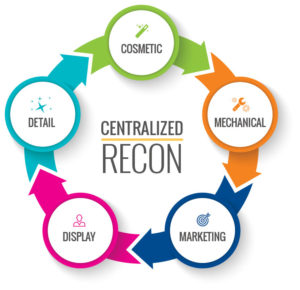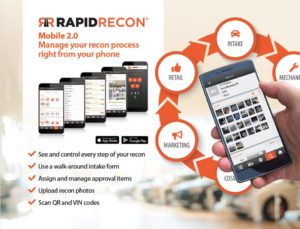15 Aug The Path to Recon Best Practices
[vc_row css_animation=”” row_type=”row” use_row_as_full_screen_section=”no” type=”full_width” angled_section=”no” text_align=”left” background_image_as_pattern=”without_pattern”][vc_column][vc_single_image image=”288″ img_size=”full” alignment=”center” style=”vc_box_shadow_3d” qode_css_animation=””][vc_column_text]On the road to more profitable used car operations, an increasing number of dealers are aligning their resources and processes to operate at the best-practices level of reconditioning performance. Their recon operations, like yours, can cut cycle time by half, getting their inventory frontline ready in three to four days, adding a week of selling time and increasing inventory turns by a factor of one to three.
The path to recon best practices starts with being honest about your current performance metrics in regards to getting a vehicle to your front line. The speed you move acquisitions from trade or auction to retail ready is best described as recon Time-to-Line (T2L). There are three stages on the way to a three-or-four-day T2L:
- Find your baseline T2L using a well- deigned workflow system matched to current processes.
- Identify and remove bottlenecks and plan your capacity to cut your baseline in half.
- Consistently achieve a three-or-four-day T2L range, with all process-step owners having real-time access to workflow data, so every car is at the right step at the right time.
Let’s now explore each of these stages and how they compare to recon best practices, based on work flow T2L software, which automates the various recon steps (customized by dealer), structures each phase to meet expected time parameters and improves communications between recon, service and the used car department by injecting true accountability within the process.
Identify Your Baseline
Expect your baseline to be higher than what you assume and what you have been hearing from your team or your 20 group. Normally you begin way behind the Recon Best Practices. When you measure the real times that each car is spending on each step, you will have your true baseline.
Put a clock to the following stages to document your current and accurate baseline:
- Inspection
- Mechanical
- Detail
- UCM approval

- Body
- Photos
If your total is six days or more, then you are a perfect candidate for implementing recon best practices. Before implementing workflow, dealers average 10 days or higher and burn an extra week of prime selling time. If you do not measure your T2L, your holding costs are probably cutting into your profitability.
Eliminate Bottlenecks
Once you put a clock on your recon processes, many opportunities show up. One of the first bottlenecks to reveal itself is organization. Without T2L accountability, your crew will lose its focus on the clock and, therefore, productivity. All steps must be completed within recon best practice limits.
A significant bottleneck is misplaced inventory. T2L software with VIN code and QR code functionality pulls vehicle details into the software upon the vehicle’s release from finance or transport. Vehicles taken out of recon to wait for special-order parts or other reasons are similarly accounted for and tracked.
Apply T2L reccon best practices first to mechanical and detail operations as they are the two crucial workflow steps. Decide the level you need to operate to hit best practices T2L. Recon best practices dictate that combination of mechanical, including inspection and parts hold, and detail must be two days or less.
The body shop will likely add another day to 20 or 30 percent of your cars, taking 4.5 days average. Consider building in some recon best practices into how work flows through the body shop to increase cycle times there, as well.
Work out an inventory photography workflow to market the vehicles online immediately. Best practice dealers are getting 10-12 photos online immediately increasing their Search Engine Optimization (SEO).
Set response standards for used car manager repair approvals. Decreasing the amount of time it takes to approve an estimate will significantly decrease your T2L. Identify how off-site subletting work is to flow into the mix and set tight parameters for that work being done.
Perhaps subletting dent and paint repair or tire and wheel detail will eliminate a bottleneck — or perhaps bringing those sublets in-house is the answer for you. Some dealers may eliminate final detail work until vehicles are on the frontline. High-line brand dealers whose clientele are highly visually aware may not want to do this, but it can be a prudent strategy for others.
On the road to more profitable used car operations, an increasing number of dealers are aligning their resources and processes to operate at the best-practices level of reconditioning performance. Their recon operations, like yours, can cut cycle time in half, getting their inventory frontline ready in three to four days, adding a week of selling time and increasing inventory turns by a factor of one to three. Where you have identified bottlenecks, estimate the time-savings potential to be gained by eliminating or reducing them.
Streamlining here not only reduces T2L, but also holding costs. This is a daily percentage of your overhead carried by each unit in inventory. NCM Associates has calculated this cost at an average of $37 per vehicle per day (higher for high-line brands), Dale Pollack estimates daily holding cost to be as high as $85 per vehicle per day until the vehicle is sold. Now you can calculate accurate holding costs to see how much gross is being lost. This will range from $230,000 to $750,000 annually for the average dealership.
Real-Time Access
The third stage is consistently achieving a three-or-four-day T2L range. What’s essential here is that within this tight T2L zone, all process-step owners must have real-time access to your recon process data. This is perhaps the only way to ensure that your crew knows where every car is, and if it is in the right step at the right time. Implementing a Work Flow Process that includes mobility through the use of mobile devices is crucial.
Work progress slows without a clearly defined and communicated way for responsible parties to know when one phase is ready and being transferred up the line to the next stage. This can be conveyed by email, text or phone to keep work moving. Use of workflow software here ensures tighter control, management and communication. Spreadsheets and whiteboards are not useful because they’re just not effective nor are they based in real time.
Recon Best practices also require a methodology for technician notes to be added to vehicle inspection screens or sheets. Notes notify advisors quickly about the parts and labor needed, so the used car manager can be alerted for his or her prompt approval and parts can be sourced and ready for the technician.
Assign ownership of every step of this new workflow. Each person in the recon process must follow a written plan for their work
and its relation to the other steps. Use text notifications and daily emailed trouble reports to keep all step owners on top of their cars and their individual metrics.![]()
For more information on recon best practices or to schedule a brief online demo of our electronic work flow system, go to https://www.rapidrecon.com .
[/vc_column_text][/vc_column][/vc_row]


Sorry, the comment form is closed at this time.